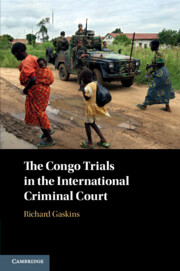Book contents
- The Congo Trials in the International Criminal Court
- The Congo Trials in the International Criminal Court
- Copyright page
- Dedication
- Epigraph
- Contents
- Acknowledgments
- A Laboratory for Global Justice
- Testing A New Court
- Back in Ituri
- The Bridge to the Hague
- 5 Battling Impunity in Ituri
- 6 ICC Structures, Dynamics, Tensions
- The Congo Trials
- Index
6 - ICC Structures, Dynamics, Tensions
from The Bridge to the Hague
Published online by Cambridge University Press: 21 September 2020
- The Congo Trials in the International Criminal Court
- The Congo Trials in the International Criminal Court
- Copyright page
- Dedication
- Epigraph
- Contents
- Acknowledgments
- A Laboratory for Global Justice
- Testing A New Court
- Back in Ituri
- The Bridge to the Hague
- 5 Battling Impunity in Ituri
- 6 ICC Structures, Dynamics, Tensions
- The Congo Trials
- Index
Summary
Responding to the humanitarian call, the ICC found its mission in conducting trials, and needed to build an implementation structure to support its outreach functions. While victims seeking justice may bring their claims to The Hague, it is up to the Court to build an apparatus for managing investigations, negotiating with member states, protecting witnesses in the field – all of it contributing to the resolution of serious conflicts. The neutrality of legal procedure protects the courtroom from political influence, but politics are inescapable as the Court deals with its practical environment. TheICC’s structural challenges include managing constraints on its jurisdiction, which favor deferring trials to national systems. As a legal body, the ICC must also conform with fixed definitions of crimes and modes of responsibility, even when the circumstances (such as African conflicts) may stretch those definitions to the limits. The dynamic enforcement of ICC rules is left to the interactive system of judges, arrayed on three different levels with distinct functions, checking and balancing the decisions of each other in a manner consistent with broad principles of legality.
Keywords
- Type
- Chapter
- Information
- The Congo Trials in the International Criminal Court , pp. 162 - 206Publisher: Cambridge University PressPrint publication year: 2020



